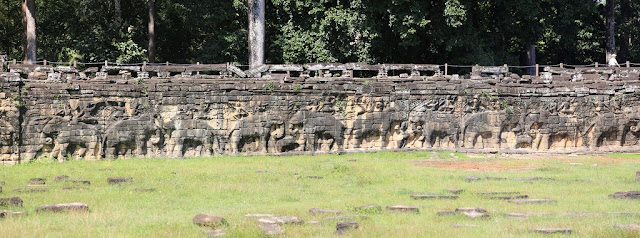Jayavarman VIII
After the death of Jayavarman VII, his son Indravarman
II (reigned 1219–1243) ascended the throne. Like his father, he was a Buddhist,
and he completed a series of temples begun under his father's rule. As a
warrior he was less successful. In the year 1220, under mounting pressure from
increasingly powerful Dai Viet (Vietnam), and its Cham alliance, the Khmer
withdrew from many of the provinces previously conquered from Champa. In the
west, his Thai subjects rebelled, establishing the first Thai kingdom at
Sukhothai and pushing back the Khmer. In the following 200 years, the Thais
would become the chief rivals of Kambuja.
 Indravarman II was succeeded by Jayavarman VIII
(reigned 1243–1295). In contrast to his predecessors, Jayavarman VIII was a
devotee of the Hindu deity Shiva and an aggressive opponent of Buddhism,
destroying many Buddha statues in the empire and converting Buddhist temples to
Hindu temples. From the outside, the empire was threatened in 1283 by the
Mongols under Kublai Khan's general Sogetu (sometimes known as Sagatu or Sodu),
who was the governor of Guangzhou, China. The king avoided war with his
powerful opponent, who ruled all of China, by paying annual tribute, starting
in 1285. Jayavarman VIII's rule ended in 1295 when he was deposed by his
son-in-law Srindravarman (reigned 1295–1309). The new king was a follower of
Theravada Buddhism, a school of Buddhism that had arrived in Southeast Asia
from Sri Lanka and subsequently spread through most of the region.
Indravarman II was succeeded by Jayavarman VIII
(reigned 1243–1295). In contrast to his predecessors, Jayavarman VIII was a
devotee of the Hindu deity Shiva and an aggressive opponent of Buddhism,
destroying many Buddha statues in the empire and converting Buddhist temples to
Hindu temples. From the outside, the empire was threatened in 1283 by the
Mongols under Kublai Khan's general Sogetu (sometimes known as Sagatu or Sodu),
who was the governor of Guangzhou, China. The king avoided war with his
powerful opponent, who ruled all of China, by paying annual tribute, starting
in 1285. Jayavarman VIII's rule ended in 1295 when he was deposed by his
son-in-law Srindravarman (reigned 1295–1309). The new king was a follower of
Theravada Buddhism, a school of Buddhism that had arrived in Southeast Asia
from Sri Lanka and subsequently spread through most of the region. In August 1296, the Chinese diplomat Zhou Daguan
arrived at Angkor and recorded, "In the recent war with the Siamese, the
country was utterly devastated." He remained at the court of king
Srindravarman until July 1297. He was neither the first nor the last Chinese
representative to visit Kambuja. His stay is notable, however, because Zhou
Daguan later wrote a detailed report on life in Angkor. His portrayal is today
one of the most important sources of understanding historical Angkor. Alongside
descriptions of several great temples (the Bayon, the Baphuon, Angkor Wat) —
his account informs us that the towers of the Bayon were once covered in gold —
the text also offers valuable information on the everyday life and the habits
of the inhabitants of Angkor.
In August 1296, the Chinese diplomat Zhou Daguan
arrived at Angkor and recorded, "In the recent war with the Siamese, the
country was utterly devastated." He remained at the court of king
Srindravarman until July 1297. He was neither the first nor the last Chinese
representative to visit Kambuja. His stay is notable, however, because Zhou
Daguan later wrote a detailed report on life in Angkor. His portrayal is today
one of the most important sources of understanding historical Angkor. Alongside
descriptions of several great temples (the Bayon, the Baphuon, Angkor Wat) —
his account informs us that the towers of the Bayon were once covered in gold —
the text also offers valuable information on the everyday life and the habits
of the inhabitants of Angkor.
-Writing by follow up Khmer King and Khmer Histories
Book.













































